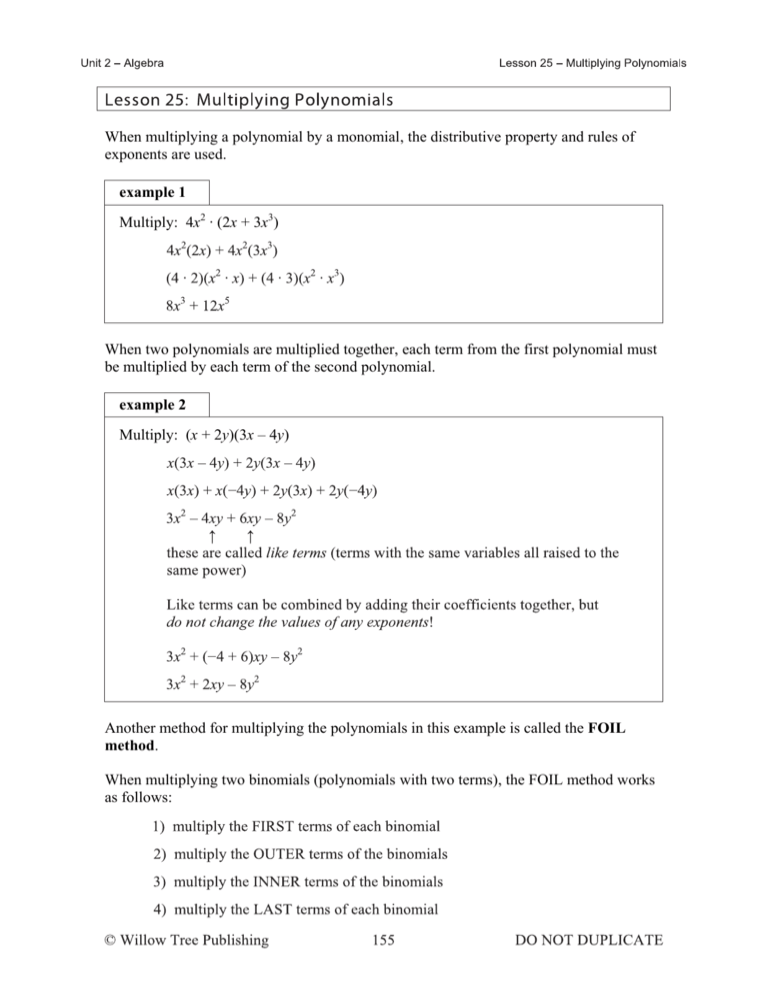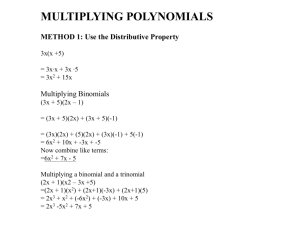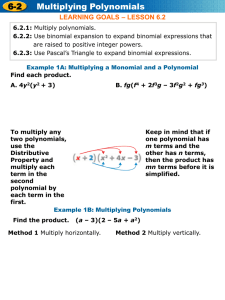When multiplying a polynomial by a monomial, the distributive
advertisement

When multiplying a polynomial by a monomial, the distributive property and rules of exponents are used. example 1 Multiply: 4x2 · (2x + 3x3) When two polynomials are multiplied together, each term from the first polynomial must be multiplied by each term of the second polynomial. example 2 Multiply: (x + 2y)(3x – 4y) Another method for multiplying the polynomials in this example is called the FOIL method. When multiplying two binomials (polynomials with two terms), the FOIL method works as follows: example 3 Multiply: (x + 2y)(3x – 4y) The FOIL method is useful for making sure no steps are overlooked, but it is only used when multiplying binomials. When multiplying any other polynomials, remember to multiply every term of the first polynomial by every term of the second polynomial. example 4 Multiply the polynomials: Special Products There are some special cases involving the multiplication of two binomials. The FOIL method can be used anytime two binomials are multiplied, but understanding the following rules will make it easier to understand future lessons about factoring polynomials. Square of a Sum When a binomial is squared, the resulting polynomial is the first term of the binomial squared, twice the two terms multiplied together, and the last term of the binomial squared. This can be proven with the FOIL method: This shortcut can be used to skip a step or two in the FOIL method. example 5 Multiply: Square of a Difference This is the same as the square of a sum, except that a minus sign appears ahead of the middle term of the resulting trinomial. example 6 Multiply: Difference of Squares The difference of squares refers to the answer that results from multiplying two binomials with the same terms, but with the last term of each binomial having opposite signs: The answer has no middle term because the like terms that result from the FOIL method cancel each other out: THIS PAGE INTENTIONALLY BLANK Name ______________________________ Find each product. 1) 2x(3x – 7) 2) −5x3(6x2 + 2y2) 3) a2b4(a2b – 3ab2) 4) 5) 5b(2b3 – 4b2 + 3b) 6) 2x3y(4x3y – x2y2 + 3xy3) 7) (x + 6)(x – 3) 8) (2y – 3)(y + 7) 9) (a – 2b)(4a + b) 10) (3m2 + n)(m – 4n) 1 3 mn 3 Find each product. 11) (x + 3)(x2 – 3x + 2) 12) (3c – 2)(6c2 + 5c – 11) 13) (m + n)(m + n) 14) (2p + 3q)(2p + 3q) 15) (3c – d)(3c – d) 16) (5g – 2h)(5g – 2h) 17) (x + y)(x – y) 18) (3a + 4b)(3a – 4b) 19) (2m2 – 1)(2m2 + 1) 20)











